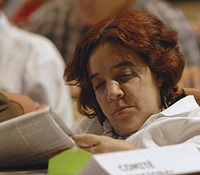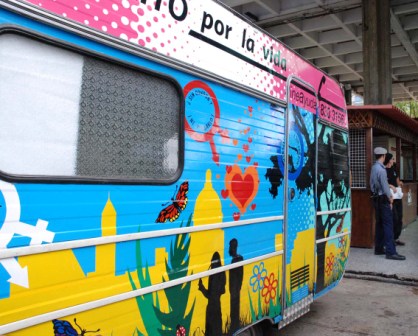Condoms Aren’t Everything
By Dalia Acosta

HAVANA TIMES, June 19 (IPS) – Posters, TV and radio public service messages, press reports and other initiatives – which for year after year have supported campaigns against AIDS in Cuba – are now aiming to go beyond the approach of “condoms for everybody.”
Promising efforts are being made to deepen people’s understanding of this pandemic’s finer points: ones that transcend the health care environment.
Although good examples are not lacking, most messages continue to put emphasis on the image of death as a synonym for AIDS (acquired immune deficiency syndrome). These communication tools ultimately serve only to promote views of catastrophe – thus encouraging complacency – while rarely ever identifying distinctions and options. Though having the best of intentions, these approaches often stigmatize sufferers and reinforce feelings of guilt or pity as forms of “solidarity.”
“The prevailing focus is on the problem only in terms of health care, though people often ignore its connections with the prevailing culture of society, social vulnerability, access to information, and sexual practices and relations between couples,” said journalist Isabel Moya, director of the Cuban magazine Mujeres (Women).
In her opinion, “In communications, like in life itself, there are no set recipes, because each social and communicational context demands it own tools for designing its mass media agenda and the form in which this is built. There exist key elements to keep in mind when dealing with the issue of HIV (human immunodeficiency virus), which causes AIDS.”
“To articulate the problem’s social, scientific and experiential aspects; to use the focus of gender as a compass to show that people can be more vulnerable depending on the way in which they represent and live out their femininity or masculinity; to give voices to people with HIV and to demand the human right of respect and acceptance,” is what she proposes.
Communication Tools for AIDS Prevention
Moya, who is also the director of the Department of Gender and Communication at the Jose Marti International Institute of Journalism, has since June 4 been conducting the seminar “Best practices for the development of a perspective on types of communication tools for the prevention of HIV/AIDS.”
The key questions for this communications initiative could be: Are the experiences of both women and men presented? Are their differences kept in mind (biological ones as well as those socially constructed), as well as diversity within the two populations and their roles in decision making? Is the language used in communication inclusive or is it sexist?
Considered to be a socializing element par excellence, the media was described in the call to the workshop as a strategic environment for promoting changes in attitudes among the public, noting the media’s impact on the formation of concepts, the reinforcement of stereotypes and – conversely – on the acceptance of new paradigms.
A survey carried out by the Cuban National Statistics Office among 30,000 individuals demonstrated this role that the media plays. Of those polled, 95.6 percent had received information about HIV/AIDS through the television, 72.2 percent by the radio, 66 percent via the written press and 65.2 percent from promotional materials.
After two days of discussions, a group of around 20 Cuban journalists, communication designers and producers are now working on the development of informational tools which will be analyzed in one month in a presentation to the National Center for the Prevention of Sexually Transmitted Diseases and HIV/AIDS (CNP).
Coordinated by CNP, the educational workshop has the support of the technical committee of projects funded in Cuba by the Global Fund to Fight AIDS, Malaria and Tuberculosis and has support from the United Nations Development Program (UNDP).
According to the Joint United Nations Program on HIV and AIDS (UNAIDS), “The world epidemic is stabilizing, but at an unacceptably high level.” Some 33 million people lived with HIV in 2007, when there was observed a decrease in new AIDS infections and mortality.
Eradicating homophobia would help combat AIDS
While women in Latin America and the Caribbean represent 35 percent of the zero-positive population (those with the virus that causes AIDS), in Cuba the epidemic continues to have a male character. On the island, 80 percent of the cases diagnosed are among men, and within this group, 85 percent are among men who have sex with other men.
“The media must disseminate messages that promote respect for sexual diversity, and then – or better yet, at the same time – it must communicate information that refers to HIV itself. The eradication of homophobia would be an important step toward the prevention of AIDS,” commented Dixie Edith Trinquete, a journalist with the magazine Bohemia.

With more than 10 years of experience in journalistic coverage of HIV/AIDS, Trinquete believes that the media must put aside its fear of the public’s reaction to certain issues and be systematic. “If messages are only broadcast on specific dates then people forget, at least until the next campaign comes along,” she cautioned.
“Just as a lack of information can be harmful, so too is an over-saturation at certain times, as well as over-saturation devoid of creativity: we continue to air the same thing in the same way.” she noted.
Moya adds that the promotion of stigmatizing and discriminatory responses in the face of the pandemic “has a lot to do with lacking information, the haste with which materials are produced; the frequent isolation between experts, producers and the public; and people being unaccustomed to seeking advice and working in multi-disciplinary efforts.”
Although Cuba exhibits low rates of HIV infection (0.05 percent of those between 15 and 24, and 0.04 percent of people between 15 and 49), specialists warn of the recent slight increase in the affected female population, the vulnerability of women in lesbian relationships and the increase in cases detected among people over 40.
However, while an analysis of prevention and sensitization campaigns showed a marked tendency toward the promotion of the use of the condoms and, in the recent period, the promotion of solidarity with zero-positive individuals and a better understanding of sexual diversity, these were directed solely toward homosexual men.
Moreover, “There is little or no representation evidenced among the black population. It is impossible to find specific efforts that address this group, and many times this affects lifestyles, regardless of whether they’re in a rural or urban environment,” said psychologist Sandra Alvarez to IPS.
Alvarez -creator of the blog Negra Cubana (Cuban Black Woman)- believes grasping the gender perspective leads to integrating diverse sources of knowledge and treating them equally, but not just by gender, also the many other situations that confront human beings: class, origin, region, race and religion.”
Although Cuba’s National Prevention Center has specific projects involving representatives of Afro-Cuban religions, and it carries out prevention actions among prostitutes, the situations of these groups are not reflected in public service messages or in press coverage, which are also trying to avoid accusations of stigmatization.
Instead, well-dressed urban white youth is the norm in prevention ads, though these are images that create false expectations within certain social and age groups limit the range of the messages and continue to conceal the host of conditions that can increase HIV risks.
According to Moya, “The absence of a broader multidimensional approach that expresses the social essence of the issue often leads to the use of a language that can stigmatize, or to messages of little problem-solving value, ones that pose the situation in simplistic black and white terms, when in fact the challenge is much more complex.”
Translation by Havana Times






One may ask how do i know? because as i have shared before here. i have a family member who is/was a homosexual and what i have not shared is that that person died of complications of AIDS about 3 yrs ago after a long 25 yr battle which was waged on 3 continents beginning in the US.
My relative always made it public never denied access by the media into thier life and spoke out whenever possible. My relative was an activist and until the choice was made to return to Cuba all was well.
To some extent, even today 2008 the consequences of HIV have been buried, systematically kept from the eyes and ears of many in the community, in the family. The secrecy and silence ease the pain of some, yet they do little to dispel fallacies and fears associated with HIV and AIDS. One fallacy being that HIV only infects gay men and intravenous drug users. Has society played a part? Yes! as well as the legal ,medical, social service, human service, and political communities.
Cubas issues next!
Suffice, that in time in Church ministries, some struggling and some thriving, they beg respan to respond to the HIV/AIDS crisis with prayer, ongoing discussion, social analysis, empirical research, education, compassion, and community action. Often, though, “the African AmericN Church as a family had denied”* that their brothers and sisters were dying and have died from AIDS. Instead, those deaths had Instead, have been reported as deaths from pneumonia or opportunistic infections. Too often, those who have AIDS have been shunned by their loved ones and by the church This was one of the reasons i became an Atty
It was more than 10 yrs in the pandemic before the church began to seek education about this world pandemic and to eventually begin to seek and provide help for its members. One example of ministering to the sick certainly calls upon all peoples to minister to one another in the midst of the human immunodeficiency virus (HIV) and Acquired Immuno Deficiency Syndrome (AIDS). In the DC community where i lived, i saw blame, denial, and fear.
When i was a younger nurse back in the early days of HIV/AIDS the focus was on blame. I had come to DC to attend one of the first HIV workshops and ended up deciding in later yrs after the western blt was discovered to go to law school because i saw more than the virus that allegedly causes AIDS. I saw people of all races facing discrimination, racism, loss of employment, shame and dignity.
Suffice, that in the US the church which was the main supporting arm of the communities was the main culprit.